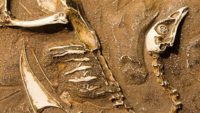The evolution of the eye has always been a dilemma for evolutionists from Darwin’s time to the present. Although Darwin, Richard Dawkins and other evolutionists have tried to explain how an eye could evolve, their solutions are clearly unsatisfactory. Many kinds of eyes exist, but no progression of eye designs from simple to complex can be produced in the natural or fossil world. Furthermore, the simplest ‘eye’, the eyespot, is not an eye but pigmented cells used for phototaxis; yet even it requires an enormously complex mechanism in order to function as a vision system. Read More: Did eyes [More]
The following brief web article was adapted from the section on alleged ‘bad designs’ in Dr Sarfati’s new book By Design, which is subtitled, Evidence for nature’s Intelligent Designer—the God of the Bible. The prostate is a walnut-sized gland in male mammals that secretes a clear, slightly alkaline liquid that comprises about 10–30% of the volume of semen. Thus it is a vital musculoglandular organ for reproduction. Some critics of creation/intelligent design complain that it is badly designed because the urethra (the tube through which urine flows out) passes through it, so if the prostate enlarges, it restricts urine [More]
Francis Crick and James Watson have used the occasion of the 50th anniversary of their discovery of the DNA double helix as an excuse to attack belief in a Creator.1 wikimedia commons Francis Crick and James Watson. Together with Maurice Wilkins they received the Noble Prize in 1962 for their discovery of the double helix structure of DNA back in 1953. A recent UK news article about the Nobel-Prize–winning pair claimed ‘scientific discoveries have a habit of offending religious susceptibilities’, and pointed out, ‘Watson and Crick are both outspoken atheists.’1 These comments attempt to reinforce the old canard [More]
Did God pander to human error in the Bible’s statements about nature? Read More
By Dr. Andrew Fabich References to Noah’s Ark abound in the culture and even have been used to describe recent efforts to store strains of microbes (instead of animals). …read more Source: AIG Daily
Is the ribosome designed? Are there differences between the ribosomes in the different domains of life? Read More at Creation.com
Humans mostly find rodents repulsive, but lots of creatures love this one. …read more Source: creation.com
Every student in US public schools will likely come across illustrations claiming the earth’s tectonic plates have been moving slowly for millions of years. …read more Source: AIG Daily
By Ken Ham Neanderthals have long been considered our evolutionary cousins and are usually portrayed as brutish and uncivilized as shown in some kids’ TV programs. But this view has consistently been shown to be wrong. We now know Neanderthals wore jewelry and makeup, made instruments and tools, and more. Of course, this is exactly what we’d expect starting with God’s Word, which teaches humans are all one race. Neanderthals simply reflect the incredibly variety within humans. And with yet another study, another evolutionary idea about Neanderthals bites the dust. The article starts with, “Neanderthals are shaking off their reputation [More]
A pristine Mesozoic bird fossil showed impressions of feathers and even some organs, including what appear to be lungs. The technical article published in the leading journal PNAS did not report any original body tissue, nor any substance that literally felt soft.1 Instead, the now-decomposed lungs left such detailed impressions that researchers saw lung microstructures. Two aspects of this set of probable lungs confirm … More… …read more Source: icr.org
Before uniformitarian geology derailed biblical history, the rails were greased by an unwarranted confidence in scientific history. What is the relationship between science, history, and truth? Carol Cleland, a leading philosopher of science, attempts an answer. Reacting to critics who claim historical science is less valid than experimental science, she defends their epistemic equality with both negative and positive arguments. Her negative argument highlights flaws in both the theory and practice of experimental science. Although her arguments ably undermine some modern distortions, her case against experimental science in this paper relies on the straw man of positivism—the idea that science [More]
By Dr. Nathaniel T. Jeanson Frello’s recent critique is helpful progress in our discussion, and it argues for the strength of the science in Replacing Darwin. …read more Source: AIG Daily
By Avery Foley Matt Walsh misses the heart of the issue in his rebuttal of Ken Ham and young-earth creation. …read more Source: AIG Daily
D.M. from the UK wrote in, sarcastically asking: “Which of the physical sciences do you believe in?” Dr Robert Carter, CMI-US, responds: Fantastic question! The short answer is, “All of them.” In fact just looking at a list of the people who work for CMI, I see PhDs in physics, nuclear physics, engineering, radiotelescopes and antenna design, geomorphology, molecular biology, plant science, plant nutrition, forestry, physical chemistry, zoology, and marine biology. We also have a medical doctor or two. This does not include the many other highly qualified people at CMI with up to master’s-level degrees. In short, we love science! We also have several theologians and educators on staff, to make for a very [More]
After speaking at a church recently, a young man approached me. I thought he might have a question. Instead, he handed me a 6-page essay he had written. It was a defence of a form of Day-Age creationism, the belief that the days of Genesis were actually long periods of time. Normally, I would not spend too much time on such a thing, but the young man impressed me as humble and studious. He also reminded me of myself at that age, when I was trying to defend that very same position. But when I read his paper, I saw [More]
The remarkable fossils found in the Cambrian rocks provide devastating evidence against Darwin’s theory. …read more Source: creation.com
By Ken Ham A short article appeared recently in an “Ask a Scientist” column in response to the question, “How did the Big Bang begin?” The scientist explains, “The Big Bang Theory is a timeline of the history of the universe. It says nothing about how the universe was created. As such, there is no beginning to the Big Bang, since it is a theory that merely describes the universe’s history.” He goes on to explain that in the Big Bang model (which he wrongly refers to as a theory, as there’s no observational evidence to support it), the entire [More]
What evidence do we see that a global Flood devastated the earth’s surface during Noah’s day—on a scale unlike anything we see today? …read more Source: AIG Daily
A scientific study aligns with the biblical account of the ancient cities of Sodom and Gomorrah being destroyed by fire and brimstone from the heavens. The book of Genesis tells the story of God sending two angels to save Lot and his family from a city where men demanded to “be intimate” with visiting men, one of the clearest biblical condemnations of homosexuality. In response, God “rained upon Sodom and Gomorrah sulfurous fire … out of heaven.” It would be hundreds of years before life returned to the region. And now scientists have found evidence of a cataclysmic event in that area, [More]
In 1994, Bolivian workers quarrying high-grade limestone for cement reached a layer with too much quartz, a hard mineral, so they left it alone.1 As quarrying continued, more and more of the unwanted layer was exposed, forming a huge cliff and revealing hundreds of dinosaur trackways. The tracks are of at least eight different kinds of dinosaurs, including a pair of titanosaurs and a herd of 16 ankylosaurs. The layer also contains the longest dinosaur trackway in the world, over 500 m (1,640 ft), by a small theropod,1 possibly a juvenile Tyrannosaurus rex.2 Read More: The Cal Orcko (‘Lime [More]
By Harry F. Sanders, III Evolutionists have serious problems with interspecific animal adoptions, while creationists are in a much better position when it comes to discussing the topic. …read more Source: AIG Daily
By Dr. Georgia Purdom Just because a family member looks a little different doesn’t make her a different race—even if she’s adopted. …read more Source: AIG Daily
Atheist pastor keeps pulpit; star has origins “close to Big Bang”; acoustic camouflage fur helps moths escape bats; most kiwis support euthanasia; and more in this week’s episode of Answers News hosted at the Creation Museum in front of a live audience. Get more answers here: https://AnswersinGenesis.org
By Kurt P. Wise Fossil Grove offers multiple evidences in support of a huge forest biome floating atop the world’s pre-Flood oceans. …read more Source: AIG Daily
By Troy Lacey A recent Pew Research poll asked several interesting and introspective questions about potential or real genetic engineering experiments on animals. …read more Source: AIG Daily
Why did God make Noah’s Flood so destructive? Why put animals on the Ark God knew would go extinct after the Flood? Read More
By Dr. Andrew A. Snelling Most people, including Christians, would still claim dogmatically that the earth looks old. But why does the earth supposedly look old? …read more Source: AIG Daily





































